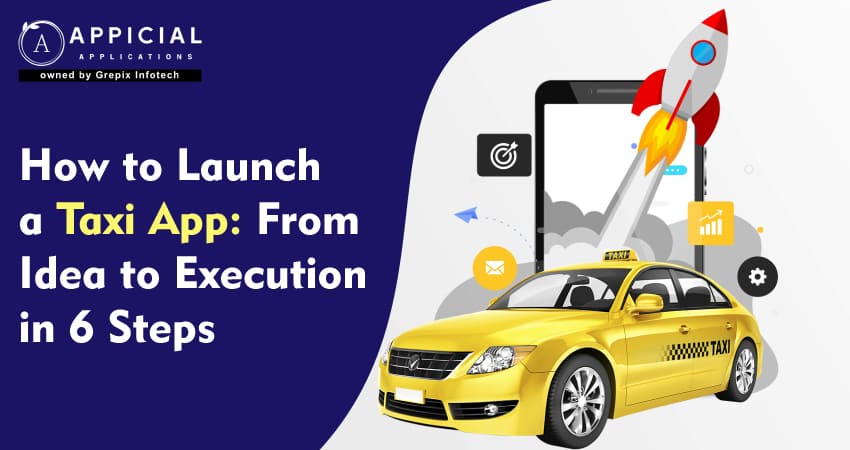
How to Launch a Taxi App: From Idea to Execution in 6 Steps
Creating a successful taxi app requires strategic planning, technical execution, and market awareness. This guide will break down the process of launching a taxi app from idea to execution in six steps, covering everything from idea and market research to development, deployment, and scaling.
Creating a successful taxi app requires careful planning, technical expertise, and market awareness. This six-step guide covers essentials from idea validation and feature definition to user-focused design, tech stack selection, and a solid launch strategy. Continuous feedback and app updates are crucial for long-term success. Appicial Applications provides a powerful, customizable platform that supports streamlined taxi app development with key features for scalability. Businesses can confidently tackle the challenges of launching and growing a taxi app, paving the way for sustained growth and customer satisfaction.
1Research and Idea Validation
Before diving into development, validating your app idea is crucial. Market research helps ensure demand and identifies competitors, gaps, and unique features that could make your app stand out. Here’s how to approach this stage:
Identify the Target Market
Investigate the needs of your target audience urban commuters, tourists, corporate clients, etc. Are they looking for more reliable service, cheaper rides, eco-friendly options, or a more secure experience? Interviews, surveys, and focus groups can provide valuable insights.
Analyze Competitors
Research the top players in the taxi and ride-hailing app market, including Uber, Lyft, and local competitors. Study their strengths, weaknesses, and customer reviews to identify gaps your app could fill.
Legal and Compliance
Taxi apps are subject to stringent local regulations. Licenses, insurance, and adherence to regulations about driver background checks and patron safety may be necessary. Consult with a legal expert on transportation app requirements for your target regions.
Revenue Model
Outline potential revenue models such as commission fees from drivers, subscription plans, in-app advertising, or premium user services. A sound revenue model helps ensure your app can generate profits and sustain growth.
2 Defining the Core Features and User Experience
Once you’ve validated your idea, it's time to define the core features of your taxi app. A basic taxi app usually has three main components: a passenger app, a driver app, and an admin panel. Here’s a breakdown of each:
1 Passenger App
- Sign-Up and Profile Management: Users should be able to sign up using their email, phone number, or social media accounts. Allow users to manage their profiles and view trip history.
- Booking Interface: A simple, intuitive interface that lets users set pick-up and drop-off locations, choose vehicle types, and book rides with a few taps.
- Real-Time GPS Tracking: Real-time tracking allows users to follow the driver’s location and estimated arrival time. It enhances convenience and security.
- Fare Calculator and Payment Options: An in-app fare calculator can provide users with an upfront fare estimate based on distance, time, and vehicle type. Support for cashless payments through credit/debit cards, digital wallets, or in-app payment systems is essential.
- Ratings and Reviews: Encourage user feedback to improve service quality. Ratings also help ensure that only high-quality drivers stay active on the platform.
2 Driver App
- Registration and Profile Verification: Drivers should be able to upload documents, such as a driver’s license and vehicle information, for verification. This can also include background checks.
- Navigation and Route Optimization: GPS navigation is essential for drivers to find the best routes to their destinations. Advanced features like route optimization and traffic forecasting can also improve efficiency.
- Earnings Dashboard: Display detailed earnings summaries so drivers can track their income from completed rides.
- Ride Management: Drivers need to accept or decline ride requests based on availability, view trip details, and communicate with passengers if needed.
3 Admin Panel
- Dashboard and Analytics: A dashboard that displays real-time data on user activity, ride requests, earnings, and other KPIs is essential for tracking performance.
- Driver and Rider Management: Admins should have control over approving drivers, managing complaints, and monitoring service quality.
- Revenue Management: This feature enables administrators to set commission rates, manage payments to drivers, and track revenue.
- Promotions and Loyalty Programs: Create and manage promotions to attract new users or reward loyal customers.
3 Design a User-Friendly UI/UX
An intuitive, appealing design can set your taxi app apart from competitors. User Experience (UX) and User Interface (UI) design are key to attracting and retaining users, so this step requires careful attention to detail:
- User Flow Mapping: Map the user journey from app launch to booking and completing a ride. Create wireframes or flowcharts that visualize each stage and interaction.
- Simplified Interface: Since the app is used in a fast-paced environment, simplicity is crucial. Ensure that primary functions (such as booking a ride or calling the driver) are accessible within a few taps.
- Consistency and Branding: Maintain a consistent color scheme, typography, and iconography that aligns with your brand’s identity. This helps make your app recognizable and trustworthy.
- Testing: Conduct usability tests with potential users to identify and resolve issues. Gather feedback on ease of navigation, speed, and overall experience to fine-tune your app before development.
4Development and Tech Stack Selection
Development is where the core features are coded, databases are configured, and the app is made functional. You can choose between two main approaches for development: native or cross-platform.
1 Choosing the Tech Stack
- Frontend: For native app development, use Swift or Objective-C for iOS and Kotlin or Java for Android. Cross-platform frameworks like React Native or Flutter can reduce costs and development time.
- Backend: A robust backend server is essential to handle ride requests, user data, and other functions. Node.js, Python with Django, or Ruby on Rails are common choices for backend frameworks.
- Database: Use trustworthy databases like MongoDB, PostgreSQL, or MySQL for storing user data, ride histories, payment information, and other data.
- APIs: GPS, payment, and messaging functionalities require third-party APIs like Google Maps for navigation, Stripe or PayPal for payments, and Twilio or Firebase for SMS and push notifications.
Building an MVP
Start with a Minimum Viable Product (MVP) to launch the basic version of your app with core features. An MVP allows you to validate the product quickly, get user feedback, and make iterative improvements.
Testing
Before launch, conduct comprehensive testing for functionality, performance, and security. Quality Assurance (QA) tests help eliminate bugs and optimize user experience.
Also Read: The Future of Ride-Hailing Apps: Trends and Innovations to Watch
5 Launch and Marketing Strategy
Once development is complete, it’s time to launch and promote your app. A well-planned launch strategy can maximize visibility and downloads.
Soft Launch
Start with a soft launch to get initial user feedback, fix last-minute issues, and optimize your app. Focus on a limited geographic area or a select group of users.Official Launch
When confident in the app’s functionality and stability, launch it on the App Store and Google Play. Follow each store’s guidelines for app submission, ensuring the app is optimized for discovery.Marketing Channels
- Social Media Campaigns: Leverage social media platforms like Instagram, Facebook, and LinkedIn for targeted ads. Short videos, testimonials, and promotional offers can help drive engagement.
- Influencer Marketing: Collaborate with local influencers to generate buzz and increase app downloads. They can demonstrate the ease and safety of using your app.
- SEO and Content Marketing: Publish articles, blog posts, and how-to guides that highlight the benefits and unique features of your taxi app. This can help improve search engine rankings and drive organic traffic.
- Referral Programs: Provide rewards to current users who recommend new drivers or passengers to the platform. This can help grow your user base cost-effectively.
Onboarding New Users
Use welcome offers like discounted rides or free trials for first-time users to encourage sign-ups. Guide users through the app’s features with a quick tutorial for a smooth first experience.
6Gather Feedback and Scale
Post-launch, gathering feedback and analyzing app performance is crucial for long-term success. This step involves constant iteration based on user insights and data analytics.
User Feedback
Collect reviews and feedback from drivers and passengers to understand their needs and identify areas for improvement. Surveys and support channels like chatbots can facilitate this.
Performance Monitoring
Track metrics such as app crashes, ride requests, and user engagement with tools like Firebase or Google Analytics. Keep an eye on user behavior to inform data-driven decisions for upcoming releases.
Feature Updates
Based on user feedback and market trends, add new features such as ride-sharing, different payment options, or in-app customer support. Continually updating your app helps retain users and stay competitive.
Expand Services
Once your taxi app has a stable user base, consider expanding services to new locations or offering premium options, such as luxury vehicles or subscription plans. Geo-expansion allows you to capture a broader audience and drive growth.
Driver Retention Programs
Retaining high-quality drivers is essential for service quality. To keep drivers happy and engaged, implement incentive programs, rewards systems, and chances for them to increase their pay.
Build Partnerships
Collaborate with local businesses or event organizers to increase your app’s visibility. Partnerships with hotels, restaurants, or tourist agencies can drive more ride requests and boost brand recognition.
Conclusion
Creating a successful taxi app requires thorough research, well-planned development, and a clear strategy for scaling and growth. From validating the idea through market research to defining features, designing a user-friendly interface, and selecting the right tech stack, each stage plays a vital role in building a high-quality, competitive taxi app. With a structured launch and marketing plan, combined with continuous feedback loops, your app can adapt and evolve to meet user needs and stay relevant in a dynamic marketplace.
For businesses seeking a reliable partner in taxi app development, Appicial Applications offers a powerful, customizable platform with a robust feature set to support seamless operations for passengers, drivers, and admins alike. Appicial brings industry experience and technical expertise to each project, ensuring clients receive an optimized, scalable, and secure app. With Appicial’s support, businesses can confidently navigate the challenges of launching and growing a taxi app, setting the stage for long-term success and a strong market presence.
Looking out to start your own venture like Uber? Try out our HireMe Uber Clone, the easiest way to kick-start your taxi business.




